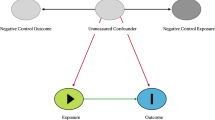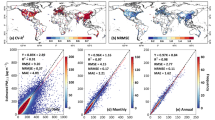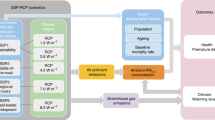Abstract
Tropospheric ozone (O3) and particulate matter (PM2.5) are associated with adverse health effects, including premature mortality. Regulation of these pollutants by the US Environmental Protection Agency has resulted in significant improvements in air quality over the last decade, as demonstrated by a national network of air quality monitors. However, ambient trends provide limited information regarding either the change in population exposure to these pollutants or how fluctuations in the levels of these pollutants might affect public health. We leverage the spatially and temporally extensive monitoring network in the US to estimate the improvements to public health associated with monitored air quality changes over a 7-year period. We estimate the impacts of monitored changes in ozone and PM2.5 on premature mortality using health impact functions based on short-term relative risk estimates for O3 and long-term relative risk estimates for PM2.5. We spatially interpolate the O3 and PM2.5 data and utilize ozone air quality data that are adjusted for meteorological variability. We estimate that reductions in monitored PM2.5 and ozone from 2000 to 2007 are associated with 22,000–60,000 PM2.5 and 880–4,100 ozone net avoided premature mortalities. The change in estimated premature mortality can be highly variable from 1 year to the next, sometimes by thousands of deaths. The estimate of avoided ozone-related mortalities is sensitive to the use of meteorologically-adjusted air quality inputs. Certain locations, including Los Angeles and Houston see an opposing trend between mortality impacts attributable to ozone and PM2.5.We find that improving air quality over the past 7 years has reduced premature mortality significantly.




Similar content being viewed by others
References
ABT Associates Incorporated (2008) Environmental Benefits and Mapping Program (Version 3.0). Bethesda, MD. Prepared for US Environmental Protection Agency Office of Air Quality Planning and Standards. Research Triangle Park, NC. Available at: http://www.epa.gov/air/benmap. Accessed Nov 2010
Bell ML, McDermott A, Zeger S, Samet JM, Dominici F (2004) Ozone and short-term mortality in 95 US urban communities, 1987–2000. JAMA 292:2372–2378
Bell ML, Dominici F, Samet JM (2005) A meta-analysis of time-series studies of ozone and mortality with comparison to the national morbidity, mortality, and air pollution study. Epidemiology 16:436–45
Camaler L, Cox W, Dolwick P (2007) The effects of meteorology on ozone in urban areas and their use in assessing ozone trends. Atmos Environ 41:7127–7137
Chen J, Zhao R, Li Z (2004) Voronoi-based K-order neighbour relations for spatial analysis. ISPRS J Photogramm Remote Sens 59(1–2):60–72
Chestnut L, Mills D (2005) A fresh look at the benefits and costs of the US acid rain program. J Environ Manage 77(3):252–266
Cox WM, Chu S (1993) Meteorologically adjusted ozone trends in urban areas: a probabilistic approach. Atmos Environ 27B:425–434
Cox WM, Chu S (1996) Assessment of interannual ozone variation in urban areas from a climatological perspective. Atmos Environ 30:2615–2625
Davidson K, Hallberg A, McCubbin D, Hubbell BJ (2007) Analysis of PM2.5 Using the Environmental Benefits Mapping and Analysis Program (BenMAP). J Toxicol Environ Health 70:332–346
Dockery DW, Pope CA, Xu XP, Spengler JD, Ware JH, Fay ME et al (1993) An association between air pollution and mortality in six US cities. N Engl J Med 329:1753–1759
GeoLytics Inc. (2002) Geolytics CensusCD® 2000 Short Form Blocks. CD-ROM Release 1.0. East Brunswick, NJ:GeoLytics, Inc. Available at: http://www.geolytics.com/. Accessed 29 Sept 2004.
Gold C (1997) Voronoi methods in GIS. In: van Kreveld M, Nievergelt J, Roos T, Widmayer P (eds) Algorithmic Foundation of Geographic Information Systems. Lecture Notes in Computer Science, vol 1340. Springer-Verlag, Berlin, pp 21–35
Hubbell BJ, Hallberg A, McCubbin D, Post E (2005) Health-related benefits of attaining the 8-hr ozone standard. Environ Health Perspect 113:73–82
Hubbell BJ, Fann N, Levy JI (2009) Methodological considerations in developing local-scale health impact assessments: balancing national regional and local data. Air Qual Atmos Health. doi:10.1007/s11869-009-0037-z [online 31 March 2009]
Ito K, De Leon SF, Lippmann M (2005) Associations between ozone and daily mortality: analysis and meta-analysis. Epidemiology 16:446–57
Krewski D, Jerrett M, Burnett RT, Ma R, Hughes E, Shi, Y, et al (2009) Extended follow-up and spatial analysis of the American Cancer Society study linking particulate air pollution and mortality. HEI Research Report, 140, Health Effects Institute, Boston, MA
Laden F, Schwartz J, Speizer FE, Dockery DW (2006) Reduction in fine particulate air pollution and mortality. Am J Respir Crit Care Med 173:667–672
Levy JI, Chemerynski SM, Sarnat JA (2005) Ozone exposure and mortality: an empiric bayes metaregression analysis. Epidemiology 16:458–68
Levy JI, Baxter LK, Schwartz J (2009) Uncertainty and variability in health-related damages from coal-fired power plants in the United States. Risk Anal. doi:10.1111/j.1539-6924.2009.01227.x [Online 9 Apr 2009]
Woods & Poole Economics Inc (2001) Population by single year of age CD. CD-ROM. Woods & Poole Economics, Inc., Washington, DC
Pope CA, Thun MJ, Namboodiri MM, Dockery DW, Evans JS, Speizer FE, Heath CW (1995) Particulate air pollution as a predictor of mortality in a prospective study of US adults. Am J Respir Crit Care Med 151:669–674
Pope CA, Burnett RT, Thun MJ, Calle EE, Krewski D, Ito K, Thurston GD (2002) Lung cancer, cardiopulmonary mortality, and long-term exposure to fine particulate air pollution. JAMA 287:1132–1141
Roman H, Walker K, Walsh TL, Connor C, Richmond HM, Hubbell BJ, Kinney PL (2008) Environ Sci Technol 42:2268–2274
Schwartz J (2005) How sensitive is the association between ozone and daily deaths to control for temperature. Resp Crit Care Med. doi:10.1164/rccm.200407-933OC
Schwartz J, Coull B, Laden F, Ryan L (2008) The effect of dose and timing of dose on the association between airborne particles and survival. Environ Health Perspect 118:64–69
Tagaris E, Liao KJ, Delucia AJ et al (2009) Potential impact of climate change on air pollution-related human health effects. Environ Sci Technol 43:4979–4988
US Environmental Protection Agency (2006a) Air Quality Criteria for Ozone and Related Photochemical Oxidants. US Environmental Protection Agency, Washington, DC, EPA/600/R-05/004aF-cF
US Environmental Protection Agency (2006b) Regulatory Impact analysis for the Particulate Matter National Ambient Air Quality Standards. Research Triangle Park
US Environmental Protection Agency (2008a) National Air Quality – Status and Trends through 2007. EPA-454/R-08-006. Research Triangle Park, NC: US Environmental Protection Agency
US Environmental Protection Agency (2008b) Regulatory impact analysis of the revisions to the national ambient air quality standards for ozone
US Environmental Protection Agency (2008c) Technology Transfer Network: Air Quality System. Washington, DC: US Environmental Protection Agency. Available at: http://www.epa.gov/ttn/airs/airsaqs/sysoverview.htm. Accessed on 5 Jan 2010.
US Environmental Protection Agency (2008d) Integrated Science Assessment for Particulate Matter (External Review Draft). US Environmental Protection Agency, Washington, DC, EPA/600/R-08/139
US Environmental Protection Agency (US EPA) (2010) Quantitative Health Risk Assessment for Particulate Matter (Second External Draft). Office of Air Quality Planning and Standards, Research Triangle Park, NC. February. Available at: http://www.epa.gov/ttn/naaqs/standards/pm/data/20100209RA2ndExternalReviewDraft.pdf. Accessed Nov 2010
Acknowledgments
This paper has not been subjected to EPA peer and administrative review; therefore, the conclusions and opinions contained herein are solely those of the authors, and should not be construed to reflect the views of the EPA. The authors thank V. Rao, B. Cox, and E. Baldridge for providing technical guidance regarding the air quality inputs to this analysis. We thank S. Anenberg for providing valuable editorial support.
Author information
Authors and Affiliations
Corresponding author
Electronic Supplementary Material
Below is the link to the electronic supplementary material.
Rights and permissions
About this article
Cite this article
Fann, N., Risley, D. The public health context for PM2.5 and ozone air quality trends. Air Qual Atmos Health 6, 1–11 (2013). https://doi.org/10.1007/s11869-010-0125-0
Received:
Accepted:
Published:
Issue Date:
DOI: https://doi.org/10.1007/s11869-010-0125-0




